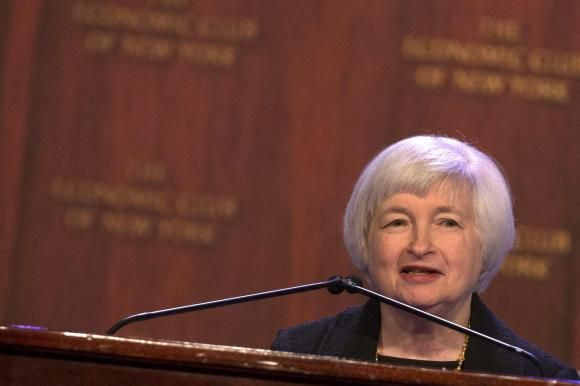Fed Bumps Up Rate-Hike Path, But Sees Lower Long-Term Rates

The U.S. Federal Reserve on Wednesday hinted at a slightly faster pace of interest rate increases starting next year, but suggested benchmark borrowing costs in the long-run would be lower than it had indicated previously.
After a two-day policy meeting, the central bank slashed its forecast for U.S. economic growth this year to a range of between 2.1 percent and 2.3 percent from an earlier projection of around 2.9 percent. But its forecasts for 2015 and 2016 were unchanged, and it expressed confidence the recovery was on track.
"Economic activity is rebounding in the current quarter and will continue to expand at a moderate pace," Fed Chair Janet Yellen told a news conference. "The economy is continuing to make progress towards our objectives" of full employment and 2 percent inflation.
As widely expected, the central bank pushed ahead with plans to wind down one of its main stimulus program, reducing its monthly asset purchases from $45 billion to $35 billion.
In updated interest rate projections, Fed officials still foresaw rates beginning to rise next year. Of 16 individual rate hike projections, the median interest rate stood at 1.125 percent by the end of 2015, up just a hair from March.
However, officials projected a slightly more aggressive path of interest rate hikes for the following year, with the end-year median placed at 2.5 percent versus 2.25 percent in March.
Importantly, Fed officials also lowered their projections for long-term interest rates, a potential sign of reduced confidence in the economy's long-run potential. The median projection was for a long-term federal funds rate of 3.75 percent, compared to 4 percent in March.
Their inflation forecasts were little changed, with inflation never topping their 2 percent target.
The Fed cut overnight rates to near zero in December 2008 as it battled the financial crisis and deep recession. The timing and pace of renewed rate increases is one of the key decisions facing the central bank as the current recovery evolves.
Financial market reaction to the Fed's statement was muted. Prices for U.S. stocks were little changed, while yields on longer-dated government bonds rose modestly. The dollar initially moved higher against the euro and the yen, but later reversed course.
STEADY AS SHE GOES
The Fed's policy statement changed little from the one issued after its last meeting in April, repeating that interest rates would remain near zero "for a considerable time" after the bond buying ends. The Fed said unemployment remained "elevated" despite recent job growth, and noted that its preferred measure of inflation was still running below its 2 percent target.
"Steady as she goes, with respect to policy," said Kim Rupert, managing director at Action Economics in San Francisco. "A lot of the doves want to make sure the recovery is for real."
The Fed provided no further details about its plans to exit other aspects of the extraordinary measures it has taken in response to the crisis. For now, it said it would continue reinvesting proceeds of its asset holdings as they mature.
Yellen has warned in the past against interpreting the individual rate projections as a clear indication of how the policy committee is likely to move. The composition of the Fed's policy-making ranks has also changed recently, with two new members on the central bank's board and a new head of the Cleveland Federal Reserve Bank, making it difficult to draw direct comparisons to the previous projections in March.
In cutting their 2014 growth forecast, Fed officials took into account the sour start the economy got this year after severe winter weather crippled activity in major cities around the country. The government said last month that GDP shrank at a 1 percent annual rate, and economists say data since then imply a much deeper contraction.
Although growth now appears to be rebounding, there remain weak spots, particularly in the housing sector. Fed officials described risks to the economy and labor market as "nearly balanced."
(Reporting by Howard Schneider and Jason Lange; Editing by Paul Simao, Timothy Ahmann and Meredith Mazzilli)
© Copyright IBTimes 2024. All rights reserved.
Request a Correction
Join the Discussion





















